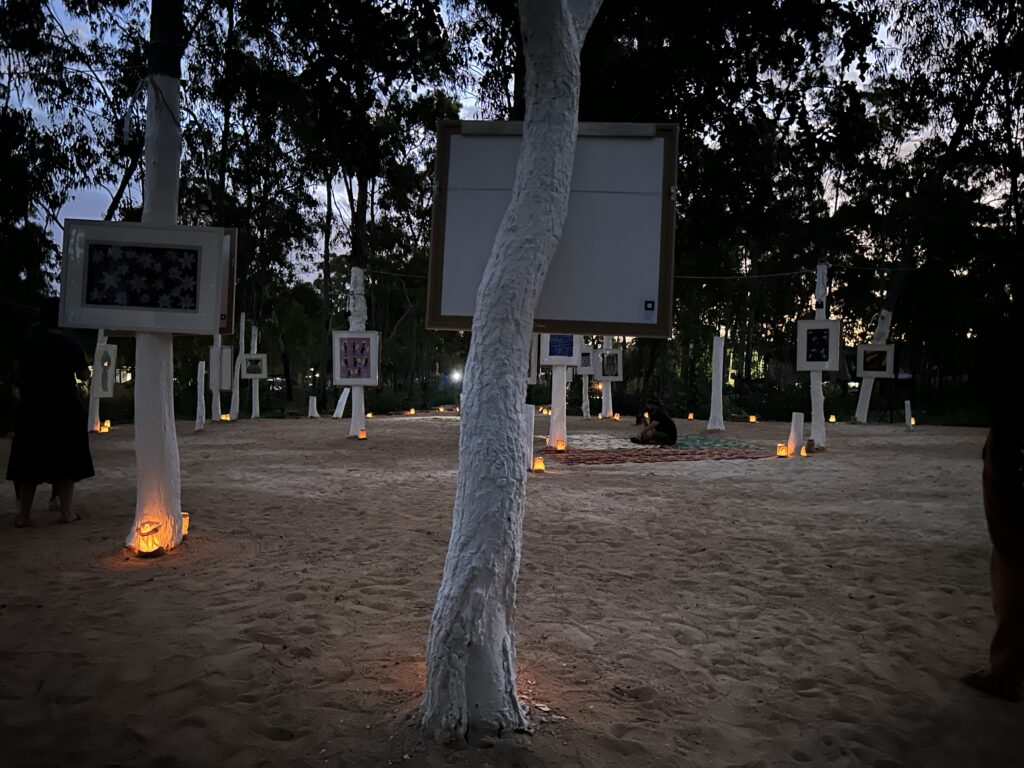Our History – Print Space
The Yirrkala Print Space began in 1995 when a purpose built area was designed to host a printing press and seize the means of production into Yolngu hands. Since, the inaugural print the studio has produced over 1,000 editions by 150 artists and is now an integral component of the Art Centre and community.
“When we first started working on lino prints we thought it was very exciting and something new for our community to learn.”
“Every print has to be the design of the artist’s own clan or connecting clans. The design has to be done very carefully so as not to mix them up, and to understand their story. We have to talk about it with other people in that clan, so when the design is printed there is no problem. It’s a similar idea to the traditional designs used in the bark paintings and the wood carving, but in printmaking we get the direction from our elders to design the image of the outside story only. In the workshop a lot of Yolngu come and watch what we do in the print studio so they can understand the process.”
– Marrnyula Mununggurr and Mundul Wunungmurra Mununggurr.
One of the few printing studios based in community – working to serve community and employ community members – it’s philosophy is to provide an environment to educate, engage and strengthen the vision of Yolngu through artistic skills development and exploration of non-traditional techniques.
It acts as a training area for emerging artists and provides employment for Indigenous. The studio has produced prints using a variety of different techniques – woodblocks, linocuts, etchings, screenprints, collography and lithography. For many of the artists this was their first exploration into the palette of the western world but the artists could still use the marwat (human hair brush) onto the zinc surface and capture the highly refined style of miny’tji (sacred clan design) particular to the area. Visiting master printmakers such as Basil Hall, Paul Machnik, John Wolseley and Sean Smith have been involved in ongoing training of Yolngu in the craft of printmaking and have collaborated on important bodies of works such as Djalkiri (2010), Seven Sisters Suite (2011) and Midawarr Suite (2014).
The platform Yirrkala Print Space has provided for artists to expand their artistic endeavours has seen prints produced by artists such as Gulumbu Yunupingu, Naminapu Maymuru-White, Djambawa Marawili and Marrnyula Mununggurr included in prestigious awards such as The Telstra Art Awards (NATSIAA) and in exhibitions worldwide. Young participants in projects – Young Ones (2010) and Yuta (2012) – have begun to establish themselves as the next generation of Yolngu artists and the Print Space offers them an empowering and valuable practice as a foundation on which to develop.
Current Day
Yirrkala Print Space is always a hub of activity. It always has been. The main event for it each year is the Gapan Gallery held out at the Garma Festival in August. In a dell of stringy bark trees an outdoor gallery is created by clearing the forest floor, covering it with white sand, painting the trees in gapan – the local white clay – and hanging the framed prints in the trees. This annual exhibition is the primary focus for the printmakers and artists and the studio is almost on a daily basis making and editioning work. A theme naturally develops between the festivals and focuses the print space. A visiting printmaker might come and influence the work; an exchange, collaboration, a workshop, or an artistic push to develop an idea, all of these things shape and mold the direction the prints take in a year. A lithograph from an exchange between Indigenous Australian and Native American artists, an etching from a workshop by Canadian master printmaker Paul Machnik, an embossed print created from a collaboration between Basil Hall and artist, a linocut from an awarding artist and one from a young man that saw itself a finalist in the 2014 Telstra National Aboriginal and Torres Strait Islander Art Awards, a small etching, a large etching, these are the layers and levels of the Yirrkala Print Space.
 – Gapan Gallery 2023
– Gapan Gallery 2023